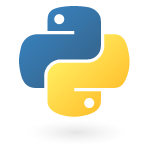Python language
In this part of the Python programming tutorial, we will talk about the Python programming language in general.Goal
The goal of this tutorial is to get you started with the Python programming language. Python is a great language to learn. It is an ideal language for those, who are new to programming. After reading this tutorial, you will be confident to continue your own studies. You can create scripts, web sites, games or desktop applications in Python. Even if you do not want to become a programmer, Python may be a great tool for occasional programmers or hobbyists.Python
 Python is a general-purpose, dynamic, object-oriented programming language. The design purpose of the Python language emphasizes programmer productivity and code readability. Python was initially developed by Guido van Rossum. It was first released in 1991. Python was inspired by ABC, Haskell, Java, Lisp, Iconand Perl programming languages. Python is a high level, general purpose, multiplatform, interpreted language. It is a minimalistic language. One of its most visible features is that it does not use semicolons nor brackets. Python uses indentation instead.
Python is a general-purpose, dynamic, object-oriented programming language. The design purpose of the Python language emphasizes programmer productivity and code readability. Python was initially developed by Guido van Rossum. It was first released in 1991. Python was inspired by ABC, Haskell, Java, Lisp, Iconand Perl programming languages. Python is a high level, general purpose, multiplatform, interpreted language. It is a minimalistic language. One of its most visible features is that it does not use semicolons nor brackets. Python uses indentation instead. There are two main branches of Python currently. Python 2.x and Python 3.x. Python 3.x breaks backward compatibility with previous releases of Python. It was created to correct some design flaws of the language and make the language more clean. The most recent version of Python 2.x is 2.7.3, and of Python 3.x 3.3.0. This tutorial covers Python 2.x versions. Most of the code is written in Python 2.x versions. It will take some time till the software base and programmers will migrate to Python 3.x. Today, Python is maintained by a large group of volunteers worldwide. Python is open source software.
Python supports several programming styles. It does not force a programmer to a specific paradigm. It supports object oriented and procedural programming. There is also a limited support for functional programming.
The official web site for the Python programming language is python.org
Implementations
Formally, Python programming language is a specification. There are three main implementations of Python. CPython, IronPython and Jython. CPython is implemented in C language. It is the most widely used implementation of Python. When people talk about Python language, they mostly mean CPython. IronPython is implemented in C#. It is part of the .NET framework. Similarly, Jython is an implementation of the Python language in Java. Jython program is translated into the Java bytecode and executed by the JVM (Java Virtual Machine). In this tutorial, we will work with CPython.Popularity
Python belongs to the most popular programming languages. Both langpop.com and tiobe sites place Python to top ten languages. Some very popular Python projects include a distributed source management tool Mercurial, a Django web framework, a PyQt GUI library or a package management utility called Yum.Python scripts
Every script in the UNIX starts with a shebang. The shebang is the first two characters in the script: #!. The shebang is followed by the path to the interpreter, which will execute our script.#!/usr/bin/pythonThis is our first Python script. The script will print "The Python tutorial" string to the console. Python scripts have py extension.
print "The Python tutorial"
$ which pythonWe can find out the path to the Python interpreter using the which command.
/usr/bin/python
Python scripts can be run in two ways.
$ python first.pyPython script is given as an argument to the interpreter.
The Python tutorial
$ chmod +x first.pyOr the common way. Use the chmod command to make the file executable. And launch it.
$ ./first.py
The Python tutorial
The next example shows a simple Ruby script.
#!/usr/bin/rubyNote the shebang and the path to the Ruby interpreter.
fruits = ["orange", "apple", "pear", "kiwi"]
fruits.each {|fruits| puts fruits}
$ ./ruby.rbThis is the output of the Ruby script.
orange
apple
pear
kiwi
Finally, we show a small Perl script.
#!/usr/bin/perlNow the concept should be clear.
$perl = "Practical Extraction and Report Language\n";
print $perl;
In this chapter, we have introduced Python language.
No comments:
Post a Comment